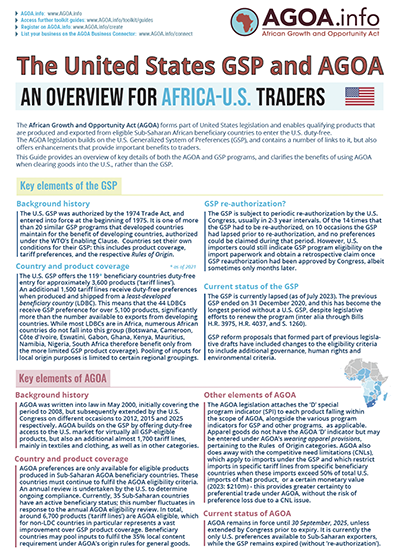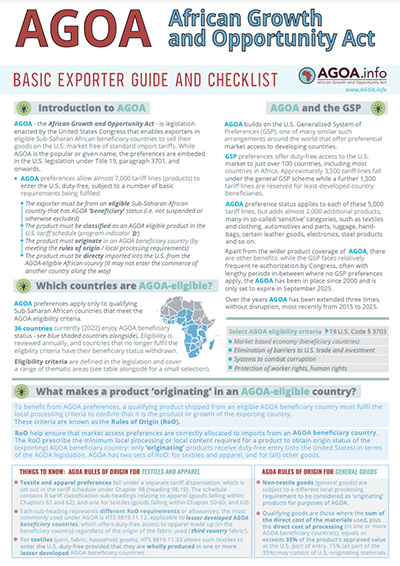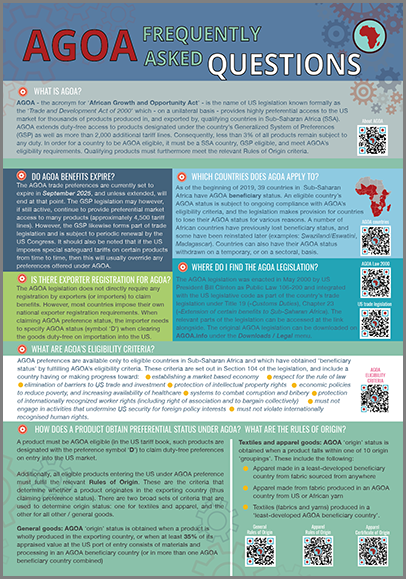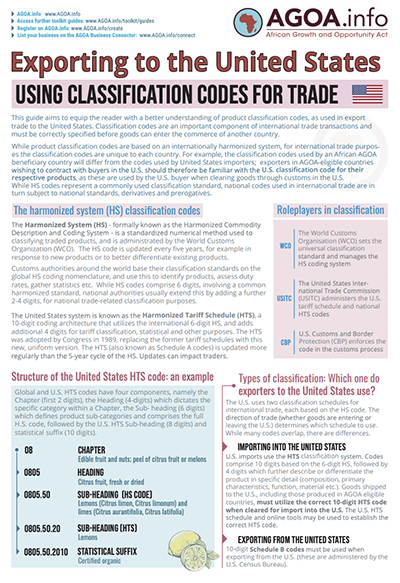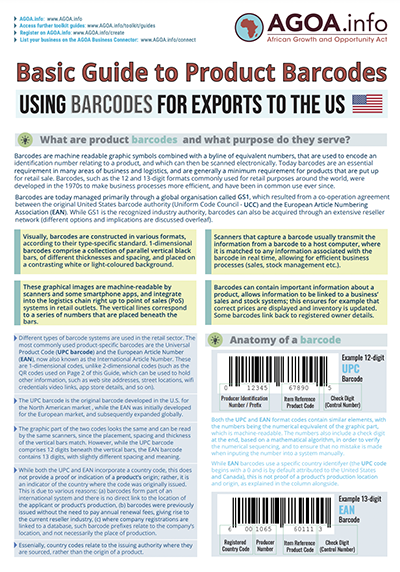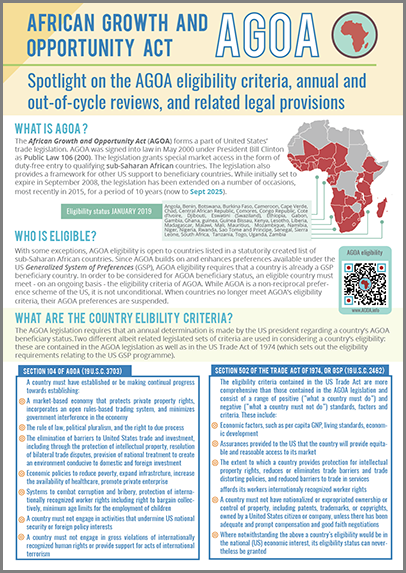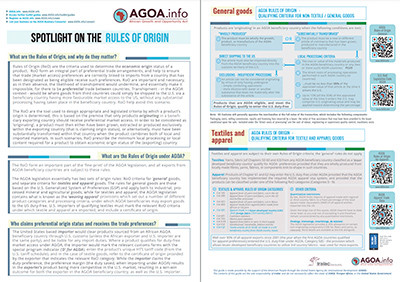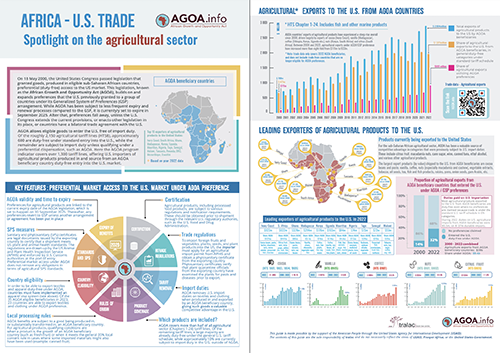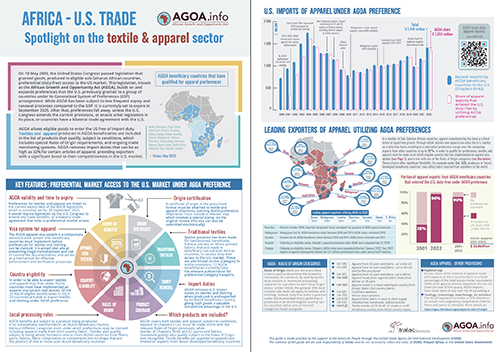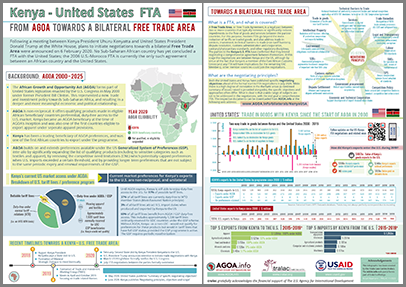Guides and Infographics
AGOA - An overview of the US GSP and AGOA, similarities and differences
The African Growth and Opportunity Act (AGOA) forms part of United States legislation and enables qualifying products that are produced and exported from eligible Sub-Saharan African beneficiary countries to enter the US duty-free. The AGOA legislation builds on the US Generalized System of Preferences (GSP), and contains a number of links to it, but also offers enhancements that provide important benefits to traders. This Guide provides an overview of key details of both the AGOA and GSP programs, and clarifies the benefits of using AGOA when clearing goods into the US, rather than through the GSP.
AGOA - Basic Exporter Guide and Checklist
AGOA - Frequently Asked Questions FAQ brochure
AGOA.info brochure that addresses various AGOA related questions, such as What is AGOA? Do AGOA benefits expire? Which countries does AGOA apply to? What about exporter registration? Where do I find the AGOA legislation? What are the AGOA eligibility criteria? How does a product obtain preferential origin status under AGOA? What benefits are offered under AGOA? What is the AGOA Forum? How do I know whether my product qualifies under AGOA? How can I obtain clarity on the preference status of my product prior to export to the US? Where do I obtain additional support relating to AGOA? Double-sided brochure.
AGOA - Guide to HTS classification codes for trade
This guide aims to equip the reader with a better understanding of product classification codes, as used in export trade to the United States (United States imports). Classification codes are an important component of international trade transactions and must be correctly specified before goods can enter the commerce of another country. While product classification codes are based on an internationally harmonized system, for international trade purposes the classification codes are unique to each country. For example, the classification codes used by an African AGOA beneficiary country will differ from the codes used by United States importers; exporters in AGOA-eligible countries wishing to contract with buyers in the U.S. should therefore be familiar with the U.S. classification code for their respective products, as these are used by the U.S. buyer when clearing goods through customs in the U.S.
AGOA - Introductory guide to Incoterms
This guide provides an overview of the International Commercial Terms, commonly known as ‘Incoterms’, which are terms used in international trade transactions involving the movement of goods, and which provide a common understanding of the parties’ responsibilities and obligations, and when risk passes from the seller to the buyer. Incoterms significantly simplify international contracting between sellers and buyers and provide clarity and certainty on various critical aspects underlying the sale and transportation of goods as these move from the seller’s premises to the buyer. Each incoterm represents a different standard, with specific obligations, and involves different points of the journey where risk passes from the seller to the buyer. Traders may rely on the underlying criteria of each respective Incoterm when choosing a specific Incoterm, making it easier to conclude a business transaction, manage the logistics process, and to resolve disputes between the parties should they arise.
AGOA - Introductory guide to product barcodes in international trade
Barcodes are machine readable graphic symbols combined with a byline of equivalent numbers, that are used to encode an identification number relating to a product, and which can then be scanned electronically. Today barcodes are an essential requirement in many areas of business and logistics, and are generally a minimum requirement for products that are put up for retail sale. Barcodes, such as the 12 and 13-digit formats commonly used for retail purposes around the world, were developed in the 1970s to make business processes more efficient, and have been in common use ever since. Barcodes are today managed primarily through a global organisation called GS1, which resulted from a co-operation agreement between the original United States barcode authority (Uniform Code Council - UCC) and the European Article Numbering Association (EAN). While GS1 is the recognized industry authority, barcodes can also be acquired through an extensive reseller network (different options and implications are discussed overleaf).
AGOA Business Connector Brochure [Updated 2023]
AGOA.info brochure on the AGOA Business Connector. See www.AGOA.info/connect Double-sided brochure, updated 2023
AGOA legal, eligibility and review provisions
An overview of AGOA's legal provisions including the eligibility criteria, annual reviews, out-of-cycle review provisions, procedures, and current eligibility status for AGOA and related textile provisions. Double-sided brochure
AGOA Rules of Origin [Updated 2023]
What are the AGOA Rules of Origin and why do they matter? Who claims origin status and who receives benefits? What are the provisions for general goods and for textiles/apparel? Double-sided brochure
AGOA sector focus - Spotlight on agriculture and trade under AGOA [Updated 2023]
An overview of key features of the export of agricultural products to the US by AGOA beneficiary countries, including cocoa, vanilla, coffee, nuts and citrus fruit. Double-sided A4 brochure. For optimised printing, set 'fit to page'. Includes trade data to end 2022
AGOA sector focus - Spotlight on textiles and trade under AGOA [Updated 2023]
An overview of key features of exports of textiles and apparel products to the US by AGOA beneficiaries, including the relevant rules of origin provisions. Double-sided A4 brochure. For optimised printing, set 'fit to page'. Includes trade data to end 2022
Brochure | Kenya-United States FTA
Information brochure on the proposed US-Kenya FTA, including trade data and negotiating principles. Double-sided A4. For printing purposes, set 'fit to page' on your printer.


